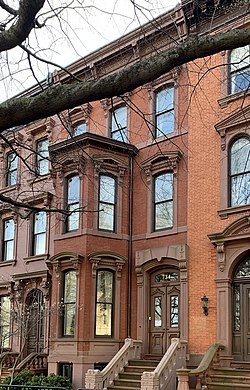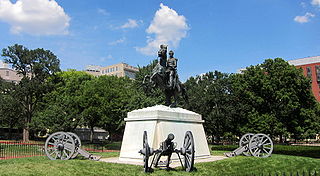
The Lafayette Square Historic District is a National Historic Landmark District in Washington, D.C., encompassing a portion of the original L'Enfant Plan for the city's core. It includes the 7-acre (2.8 ha) Lafayette Square portion of President's Park, all of the buildings facing it except the White House, and the buildings flanking the White House to the east and west. The district was designated a National Historic Landmark in 1970.

Ammadelle is a historic house at 637 North Lamar Boulevard in Oxford, Mississippi. Built in 1859, it is an Italianate mansion designed by Calvert Vaux, which he regarded as one of his finest works. It was designated a National Historic Landmark in 1974.

The John Paul Jones House is a historic house at 43 Middle Street in Portsmouth, New Hampshire. Now a historic house museum and a National Historic Landmark, it is where American Revolutionary War naval hero John Paul Jones, resided from 1781-82 when it was operated as a boarding house. He also lived in a home in Fredericksburg, Virginia, on Caroline Street, owned by his brother.

The Cherokee National Capitol, now the Cherokee Nation Courthouse, is a historic tribal government building in Tahlequah, Oklahoma. Completed in 1869, it served as the capitol building of the Cherokee Nation from 1869 to 1907, when Oklahoma became a state. It now serves as the site of the tribal supreme court and judicial branch. It was designated a National Historic Landmark in 1961 for its role in the Nation's history.

The Museum of Newport History is a history museum in the Old Brick Market building in the heart of Newport, Rhode Island, United States. It is owned and operated by the Newport Historical Society at 127 Thames Street on Washington Square. The building, designed by noted 18th-century American architect Peter Harrison and built in the 1760s, is a National Historic Landmark.

Prospect House, known also as just Prospect, is a historic house on the Princeton University campus in Princeton, Mercer County, New Jersey, United States. Built in 1851, it is a fine example of the work of architect John Notman who helped popularize Italianate architecture in America. Notable residents include Woodrow Wilson during his tenure as president of the university. The building now serves as a faculty club. It was designated a National Historic Landmark in 1985 for its architecture and historic associations.

The Charlotte Forten Grimké House is a historic house at 1608 R Street NW in the Dupont Circle neighborhood of Northwest Washington, D.C., United States. From 1881 to 1886, the house was home to Charlotte Forten Grimké (1837–1914), an African-American abolitionist and educator, one of the first Northerners to enter Union-controlled areas of the South during the American Civil War in order to teach freedmen and their children. The house was designated a National Historic Landmark in 1976.
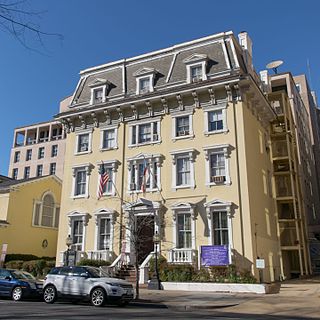
Ashburton House, also known as St. John's Church Parish House or the British Legation, is a historic house at 1525 H Street NW, on Lafayette Square in Washington, D.C. Built in 1836, it is notable as the residence of Lord Ashburton in 1842, during which time negotiations took place there culminating the Webster–Ashburton Treaty. This settled a long list of border disputes between the U.S. and the British provinces that are now Canada, and ended the Aroostook War. It was declared a National Historic Landmark in 1973. It presently serves as the parish house for St. John's Episcopal Church.

The Vernon House is a historic house in Newport, Rhode Island built in 1758 for Metcalf Bowler. The house is an architecturally distinguished colonial-era house with a construction history probably dating back to the late 17th century, with alterations made in the 18th century, possibly by architect Peter Harrison. During the American Revolutionary War this house served as the headquarters of the Comte de Rochambeau, commander of the French forces stationed in Newport 1780–1783. The house was designated a National Historic Landmark in 1968.

The Peter Parker House, also known as the former headquarters of the Carnegie Endowment for International Peace, is a historic row house at 700 Jackson Place NW in Washington D.C. Built in 1860, it is historically significant for its association with the Carnegie Endowment, whose headquarters it was from its founding in 1910 until 1948. The building was declared a National Historic Landmark in 1974. It has since been incorporated into the Blair House complex serving high-profile official visitors to the capital.
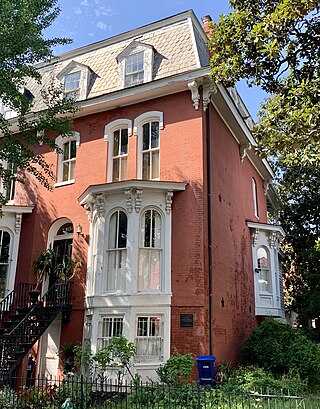
The Zalmon Richards House is a historic house in Washington, D.C. A Second Empire rowhouse, it was home from 1882 until his death of Zalmon Richards (1811–1899), founder of the National Education Association. It was declared a National Historic Landmark in 1965. It is a private residence.

The Oscar W. Underwood House is a historic house located in the Foggy Bottom neighborhood Northwest, Washington, D.C. It is nationally significant for its association with Major Archibald Butt, and painter Francis Davis Millet – both of whom died in the Titanic disaster on April 15, 1912 – and also Alabama politician Oscar Underwood (1862–1929) who lived there 1914–1925. It was the first long-term home of the Washington College of Law, the nation's first law school founded and run by women. The property was declared a National Historic Landmark in 1976. The building presently houses a legal aid clinic operated by George Washington University.
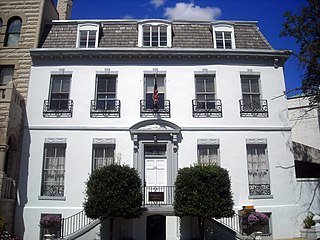
The Hiram W. Johnson House, also known as Mountjoy Bayly House, Chaplains Memorial Building or Parkington, is an historic house at 122 Maryland Avenue, Northeast, Washington, D.C., in the Capitol Hill neighborhood. Built about 1822, it is most notable as the home of Hiram Johnson (1866–1945), a prominent force in the Progressive Party of the early 20th century and its vice presidential candidate under Theodore Roosevelt in the 1912 election. It was declared a National Historic Landmark in 1976, and contributing property to the Capitol Hill Historic District.

Mount Clare, also known as Mount Clare Mansion and generally known today as the Mount Clare Museum House, is the oldest Colonial-era structure in the City of Baltimore, Maryland, U.S.A. The Georgian style of architecture plantation house exhibits a somewhat altered five-part plan. It was built on a Carroll family plantation beginning in 1763 by barrister Charles Carroll the Barrister, (1723–1783), a descendant of the last Gaelic Lords of Éile in Ireland and a distant relative of the much better-known Charles Carroll of Carrollton, (1737–1832), longest living signer of the Declaration of Independence and the richest man in America in his later years, also the layer of the First Stone of the new Baltimore and Ohio Railroad, just a short distance away in 1828.

The Carroll County Court House is a historic former courthouse at 20 Courthouse Square in Ossipee, New Hampshire. Built in 1916, it is the county's oldest surviving courthouse, and a prominent local example of Colonial Revival architecture. It housed county offices until the 1970s, was a courthouse until 2004, and now houses the Ossipee Historical Society. The building was added to the National Register of Historic Places in 2007, and the New Hampshire State Register of Historic Places in 2003.

The Swanton Christian Church, formerly the First Congregational Church of Swanton, Old Brick Meetinghouse, and New Wine Christian Fellowship is a historic church in the village of Swanton, Vermont. Built in 1823 and remodeled in 1869, it is a prominent landmark in the village, and a fine local example of Italianate styling on a Federal period building. It was listed on the National Register of Historic Places in 2001.

The Glover House, also known as the Budd House, is a historic house at 50 Main Street in Newtown, Connecticut. Built in 1869, it is a good local example of Second Empire architecture, and is further notable for the long tenancy of a single prominent local family. It was listed on the National Register of Historic Places in 1982.

The Henry J. Crippen House is a historic two-family house at 189-191 North Main Street in Concord, New Hampshire. Built about 1879, it is one of a dwindling number of little-altered surviving Second Empire residences on the city's Main Street. Now converted to professional offices, it was listed on the National Register of Historic Places in 1983.

The Gov. Meshech Weare House is a historic house on Exeter Road in Hampton Falls, New Hampshire. It was built in 1723, and is notable as the home of Meshech Weare, the first Governor of New Hampshire after it declared independence from the British crown. It was listed on the National Register of Historic Places in 1973.

The Capt. John P. Nichols House is a historic house at 121 East Main Street in Searsport, Maine. Built in 1865 for a ship's captain from a prominent local family, it is one of Waldo County's finest examples of Italianate architecture, with a particularly elaborate cupola. The house was listed on the National Register of Historic Places in 1983. It is now the Homeport Inn.
